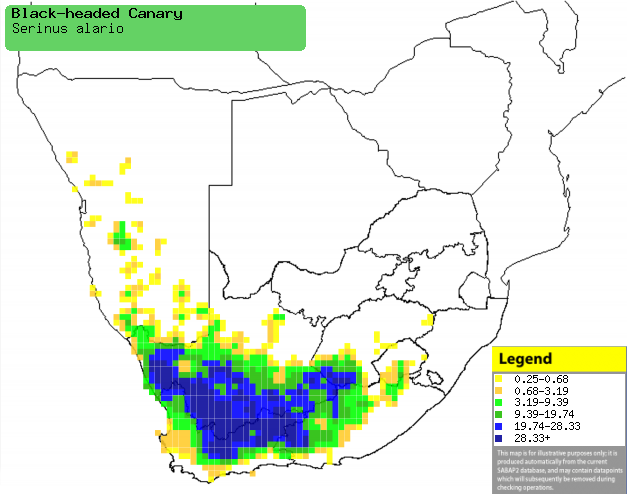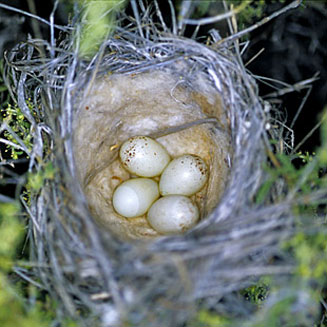|
Serinus alario (Black-headed
canary)
Swartkopkanarie [Afrikaans]; Alario-kanarie [Dutch]; Serin
alario [French]; Alariogirlitz [German]; Canário-de-cabeça-preta [Portuguese]
Life
> Eukaryotes >
Opisthokonta
> Metazoa (animals) >
Bilateria >
Deuterostomia > Chordata >
Craniata > Vertebrata (vertebrates) > Gnathostomata (jawed
vertebrates) > Teleostomi (teleost fish) > Osteichthyes (bony fish) > Class:
Sarcopterygii (lobe-finned
fish) > Stegocephalia (terrestrial
vertebrates) > Tetrapoda
(four-legged vertebrates) > Reptiliomorpha > Amniota >
Reptilia (reptiles) >
Romeriida > Diapsida > Archosauromorpha > Archosauria >
Dinosauria
(dinosaurs) > Saurischia > Theropoda (bipedal predatory dinosaurs) >
Coelurosauria > Maniraptora > Aves
(birds) >
Order: Passeriformes > Family: Fringillidae
Distribution and habitat
Endemic to southern Africa, occurring from central Namibia
to the Northern, Western and Eastern Cape, the Free State and Lesotho. It
generally prefers arid to semi-arid shrublands on rocky slopes, coastal karroid
shrubland, alpine and sub-alpine grassland, perennial desert grassland with
scattered trees and bushes, road verges, old croplands and Karoo village
gardens.
|
 |
|
Distribution of Black-headed canary in southern
Africa, based on statistical smoothing of the records from first SA Bird
Atlas Project (©
Animal Demography unit, University of
Cape Town; smoothing by Birgit Erni and Francesca Little). Colours range
from dark blue (most common) through to yellow (least common).
See here for the latest distribution
from the SABAP2. |
Movements and migrations
Resident and nomadic, moving in search of areas
which have experienced recent rainfall; generally it heads east in
summer and west in winter following general rain patterns.
Food
It mainly eats seeds taken from the ground or directly from
forbs and grasses. The following food items have been recorded
in its diet:
- Seeds
- grasses
- forbs
- Galenia papulosa (vanwyksopslags)
- Galenia pubescens
- Chrysocoma (bitterbossies)
- Felicia
- Gazania (botterbloms)
- Atriplex lindleyi (alien Blasiebrak)
- garden weeds
- Boerhavia
- Lepidium (chickweed)
- Chenopodium almum (Fat hen)
- Chenopodium murale (Misbredie)
Breeding
- Monogamous and probably a solitary nester, although pairs may breed within
10-50 metres of each other.
- The nest (see image below) is built solely by the female in about 4-6
days, consisting of a shallow deep cup of dry grass, fine twigs and bark
strips from Lammerlat (Asclepias buchenaviana) and honey-thorns (Lycium)
lined with the fluffy seeds of Karoo rosemaries (Eriocephalus) or
other downy or cottony plant material. It is typically placed close to
ground in a shrub (such as Crassula) or a small tree, often near a
ditch or small rock face.
 |
|
|
Black-headed canary nest with eggs, Aggeneys,
South Africa. [photo Warwick Tarboton ©] |
|
- Egg-laying season is almost year-round, peaking from about July-November.
- It lays 2-5 eggs, which are incubated solely by the female for about
13-14 days (recorded in captivity).
- The chicks are fed by both parents, leaving the nest in captivity after
roughly 19-20 days.
Threats
Not threatened, although its range seems to have contracted
in the Western Cape and Botswana (where it is no longer present), it is in
demand for the cage bird trade and is not particularly well represented in
protected areas.
References
-
Hockey PAR, Dean WRJ and Ryan PG 2005. Roberts
- Birds of southern Africa, VIIth ed. The Trustees of the John Voelcker
Bird Book Fund, Cape Town.
|
